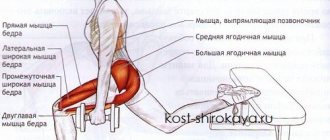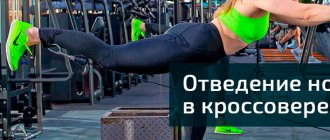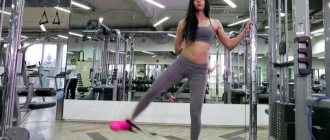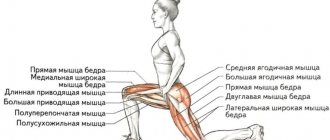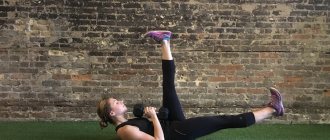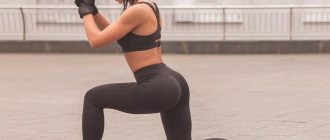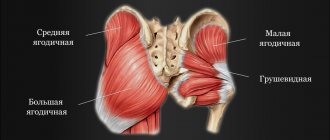Back lunges are a classic leg exercise. They are used in bodybuilding for the development of quadriceps, hamstrings and buttocks, as well as in other sports. Powerlifters and weightlifters do lunges to improve strength in the main movement. Runners - in order to run the distance more consistently and not suffer from distortions in the hips and ankles. In regular fitness, this movement is used as a general developmental one. For many, this may be the main leg exercise on the plan.
What are back lunges?
The lunge is a knee-dominant exercise, meaning that the initial movement occurs at the knee. This is a unilateral exercise (performed on one side) and is more dynamic than the double leg squat, where both feet remain stationary.
When performing a reverse lunge, you will step back with one leg. You bend your back leg so that your back knee is almost touching the ground and your front knee is roughly parallel to the floor. Your front foot down is the one that will work.
Workout plan for slender legs
We offer you a ready-made training plan based on reverse lunges for girls, which will help improve the shape of your legs and tighten your buttocks. If you are a beginner, then train without weights. Working with your weight is enough to achieve high-quality results. More experienced practitioners can use dumbbells.
Perform the exercises for the specified number of repetitions. Rest 30-60 seconds between sets, 2-3 minutes between exercises. You can change the number of repetitions and sets to your liking.
See our selection of exercises:
- Top 60 Best Cardio Exercises
- Top 50 best leg exercises
- Top 50 best exercises for buttocks
- Top 50 Best Abdominal Exercises
- Top 30 best arm exercises
Squat + Back Lunge
This exercise combines the benefits of squats and reverse lunges. An ideal exercise for eliminating breeches and pumping up the buttocks. Perform 10-12 reps on each side in 3 sets.
Plie squat
Plie squats help get rid of fat deposits in the inner thighs and make your legs slim and toned. Perform 12-15 reps on each side for 4 sets.
Back lunge touching the floor
Let's add a fat-burning exercise to our workout to not only strengthen muscles, but also burn more calories. Perform 10-12 reps on each side in 3 sets.
One leg bridge
Glute bridges help to work the gluteal muscles and the back of the thigh in isolation. Perform 12-15 reps on each side in 3 sets.
Pulling the leg back with pulsation
And one more focused exercise on the buttocks and back of the thigh. Perform 10-12 reps on each side in 3 sets.
Benefits of doing reverse lunges
Back lunges effectively develop the muscles of the legs, allowing you to alternately distribute the load on each side. This is a universal exercise for men and women that can be performed both at home and in the gym.
- When performed correctly, they do not cause strain on muscles, ligaments and do not harm joints.
- Excellent pumping of the gluteal muscles, hamstrings and quadriceps.
- Back lunges significantly reduce stress on the knees, making them optimal for beginners.
- The exercise can be performed with or without weights.
- It is easy to focus the load on different muscle groups of the lower extremities. It is enough to choose the optimal variation of the exercise and step width.
- During the execution, not only large muscle groups are worked, but also the internal muscles of the thigh, which are difficult to work with standard squats and bench presses in a machine.
Back lunges are a universal sports element that will find its place in the training of every athlete. It is suitable for both strength and high-repetition training, helping to effectively burn excess subcutaneous fat. Considering the heavy load on almost all the muscles of the lower extremities, it is basic, so every athlete must know it.
What muscles work
Back lunges are a great strengthening exercise. They work the quads, glutes, hamstrings and calves.
However, when doing forward lunges, you tend to work your quads more than your glutes. And when you do reverse lunges, you tend to work your glutes a little more.
Squats are the king of all exercises
Squats are rightfully called the “king” of all exercises. If you want to squat effectively, then first of all you need to perform the exercise well. Otherwise, you may get injured and thereby stop on your way to your desired goal.
The main reasons why you should definitely squat are:
- get power
- build muscle mass
- burn fat
- improve your physical fitness
- increase your stamina
- strengthen bones and joints
- improve flexibility
- develop sports discipline
As with any exercise, there are a few rules you should follow when doing squats. Keep in mind that the most important thing is to learn and understand the technique before experimenting with squat variations. While doing squats, you should not experience any unusual pain , and after training you should give your body enough time to regenerate.
Execution technique
- Stand with your feet shoulder-width apart.
- Step back with your right foot, landing on the ball of your right foot and keeping your right heel off the ground.
- Bend both knees to 90 degrees. Focus on keeping your core tight and your hips tucked in (don't stick your butt out). Sometimes it can be helpful to place your hands on your hips to make sure they are not leaning to the side, forward or back.
- Push through the heel of your left foot to return to the starting position.
You can do all reps in a row or alternate sides
Basic mistakes
- Tilt of the body forward and backward;
- Amplitude too small;
- Artificial reduction in step length;
- Bringing the knee behind the toe line;
- Shifting the center of gravity from heel to toe;
- Narrow feet in the starting position;
- Parallel feet;
- Pushing the toe off the floor.
How to do reverse lunges
The reverse lunge technique, despite the chosen variation, has the same base. Without precise execution, doing the exercise is pointless. First, you risk serious injury. Secondly, incorrect execution loads the wrong muscles, showing zero results. Study the step-by-step technique in detail, focusing carefully on each step.
Reverse lunge technique
The reverse lunge technique seems difficult only at the beginning of classes. Gradually you will bring it to automaticity. The main thing is to remember the step-by-step exercise plan. So how to do back lunges like a pro?
- Take a shoulder-width stance, straighten your shoulders, and straighten your back. Place your hands on your belt, or fold them near your chest, or press them to your body with the taken shells.
- Take a step back, placing your back foot on your toes and your supporting foot on your entire foot. Adjust the width of the step so that the back leg barely touches the floor with the knee, and the supporting leg stands in the fold at a right angle between the shin and thigh. Inhale at the same time as you lunge.
- As you exhale, forcefully lift your pelvis, focusing on your front foot. Bring your back leg into the starting phase at the same time.
- Repeat the exercise alternately, or with emphasis on one leg. The variation depends on your preference as well as your fitness level.
Back lunges require control of some nuances that will help you avoid injury, as well as effectively load the necessary muscles.
What should you pay attention to?
Reverse lunges have several important nuances:
- In the lower amplitude, the heel of the hind leg forms a straight line and does not warp.
- The back leg does not need to be placed on the knee. Maintain a short distance from the floor, which is especially important when doing pulse lunges.
- In the lower phase, the knee of the working leg is level with the toe and does not move forward. This is necessary to avoid excessive stress on the knee joint.
- Lower your shoulders, keep your posture straight and do not lean your body forward. For convenience, direct your gaze in front of you so as not to tilt your head or look at the floor.
- The pelvic bones point forward. Do not rock your pelvis, do not turn it to the sides, securing it in a stable position.
- At the peak point of the lift, for better stabilization, it is worth tightening the muscles of the abs and buttocks. This advice is especially important for beginner athletes.
Lunges for women and lunges for men differ not in the type of execution, but in the goals pursued. Representatives of the fair sex form beautiful shapes of their legs and buttocks. Men, in turn, develop the relief and volume of their hips with exercise, preferring methods with additional weights.
Main mistakes during execution?
When figuring out how to perform back lunges, it’s easy to make a lot of common mistakes. For example:
- There is no need to place both legs in one straight line. Maintaining balance in this position is almost impossible, especially for beginners. The exercise starts in a shoulder-width position. Keep your feet at the same width throughout the entire exercise.
- Do not lift the heel of your supporting leg off the floor. This occurs due to the strong movement of the knee forward of the toe, which must be strictly avoided. The problem can be solved by increasing the length of the step back to achieve a right angle of the front leg in the bend of the thigh and shin.
- Don't tilt your torso. Posture should be fixed strictly perpendicular to the floor. Do not rotate your torso/pelvis. Otherwise, all the load will go away from your legs, your balance will be lost, and your knees will suffer from excess stress.
Start reverse lunges at a slow pace. Take your time while establishing the technique and pay attention to the tension of each working muscle.
What muscles work?
During the execution, the following muscles are activated:
- Quadriceps and hamstrings
- Gluteus major muscle group
- Gastrocnemius and soleus muscles
- Hard-to-reach inner thigh muscles
- Core muscles
Thanks to reverse lunges, not only strength indicators increase, but also muscle volume. The lower limbs become stronger and more proportional. This is an indispensable exercise for both beginners and experienced practitioners. Girls love reverse lunges for the work of the gluteal muscles and hamstrings, men love them for the reduced load on the knees compared to forward lunges, so they can be practiced with more weight without injuring the joints.
For beginners, you can perform reverse lunges first on one leg, then on the other - this will make it easier to maintain balance.
Contraindications
All contraindications to performing back lunges in place come down to the health status and individual characteristics of each athlete. Physical exercise has no generally accepted contraindications. This is one of the “home” movements that a person does every day (for example, tying his shoelaces). However, due to the stress on some areas, lunges may not be advisable in the following cases:
- For knee injuries.
- For hernias of the lumbar spine in the acute stage.
- For arthrosis of the knee joint.
- Exercise is also not recommended for people who are prescribed limited movement (for example, recovering from surgery).
Bulgarian lunges with dumbbells
Tired of regular lunges? Try Bulgarian lunges with dumbbells.
Bulgarian lunges: execution technique
- take dumbbells in your hands;
- place the foot of your back leg on the bench (height - just below your knee);
- the other leg is in front, slightly bent at the knee;
- standing still, lower yourself down, bending your front leg until your thigh is parallel to the floor (knee does not go beyond your toe);
- if your knee extends beyond your toes, place your front foot a little further from the bench.
- repeat 10-12 times, change working leg and do another 10-12 times
- This is 1 approach, you need 3 in total.
When you do the Bulgarian lunges exercise for the first time, practice the technique without dumbbells. You need to learn how to perform lunges while maintaining your balance - you will “sway” to the sides. Don’t worry, the second or third time it’s easier to keep your balance and you’ll be able to do Bulgarian lunges with dumbbells in your hands correctly.
Number of repetitions
You can either do lunges on each leg in turn (16-20 times in total), or first on one leg 8-10 times, then on the second 8-10 times.
What equipment can be used
You can do reverse lunges with dumbbells or kettlebells, holding them at your sides or horizontally. If you have access to a barbell, you can also do reverse lunges in the same way, but make sure you master all the other variations first.
Back lunges with dumbbells
Back lunges with barbell
Back lunges with kettlebell
Back lunges with a fitness band
What alternatives are there to this exercise?
Lunges with dumbbells are an effective exercise for the buttocks and thighs, and should not be ignored unless there is a compelling reason to do so. If axial load on the spine is contraindicated for you, try performing lunges in a hack machine or Smith machine. This way you will not only protect your spine, but also work on your target muscle groups in more isolation.
You can perform steps onto a box or other hill ; the biomechanics of this movement and classic forward lunges are almost the same, and in terms of the effectiveness of steps, they are in no way inferior to lunges. Watch the position of your body and perform this exercise with a straight back, without leaning forward.
Pistol
Single-leg pistol squats can also replace cross lunges, but performing this exercise in a high rep range will be harder for most athletes since single-leg squats require more control and balance.
Sissy squats
Sissy squats are a technically difficult and traumatic, but at the same time incredibly effective exercise. We hold onto some support with our hands, direct our pelvis and knees forward, and ourselves lean back as far as possible. We perform the movement until the biceps of the thigh lies on the calf muscle, and the knees are extended as far as possible beyond the level of the toes. The unusual thing about this exercise is that here we rely not on the heel or the entire foot, but on the toe. Huge range of motion, isolated and targeted work of the quadriceps. If you don't want to do forward lunges or cross lunges, try doing sissy squats at the end of your leg workout, when all the ligaments and muscles are fairly tired. It’s hard, painful, difficult, but effective.
Jumping on a box
Box jumps or spring jumps are less effective for the glutes and thighs than classic lunges, but can be a great complement to forward lunges or cross lunges. Try doing several sets of lunges and jumping jacks in a row without stopping for a great, functional cardio workout.
For beginners, it is best to perform the exercise without additional weights. This way you will be able to perform lunges more technically, since you will not collapse under the weight of a dumbbell or barbell.
What is the difference between backward lunges and forward lunges?
Both forward lunges and reverse lunges are excellent exercises for strengthening one leg, making them a useful tool for identifying and correcting any muscle imbalances that may arise between the right and left sides.
But there are several important differences between the two types of lunges. First, the reverse lunge is generally more beginner-friendly because it requires much less stability than the forward lunge.
When performing forward lunges, the forward step is the main driver of strength. You need your glutes, hamstrings, quads, and other front leg muscles to slow you down and then bring you back to the starting position. And in a reverse lunge, the stationary leg is the main engine of force, making it easier to control.
Tip: The most effective is considered to be alternating different techniques over weeks or workouts.
Increased efficiency
- The greater the weight of the weight, the more difficult the exercise. It will be easier if you use dumbbells, as it is easier to maintain balance with them. With a barbell, you can do the exercise in a lower repetition mode and with more weight, the choice is yours.
- The full amplitude option will be more effective; if you use a shortened amplitude, you won’t be able to work the muscles as well;
- It can also be made more challenging by using sandbags and other types of functional equipment;
- You can also perform lunges from a high platform, or use a low one to start with;
- The exercise will be more effective if you do the movement alternately and return the leg to the starting position each time;
- You can increase efficiency by wrapping a rubber shock absorber around your hips, a method used in running and related disciplines;
- Lunges will be more effective if the lower leg is held vertically, this is suitable for people who tend to bend their knees too much. This way you can rest your shin on the bench;
- Lunges can also be performed with the “back” foot on a small ball, barefoot, or stand, this will help develop balance;
- If there is no weight, it makes sense to add a little jumping load - plyometrics;
- Improving the functioning of the lower extremities in general will also help you progress in lunges. If there is not enough adductor strength to support the knee, you can do isolation exercises on the adductors;
- Some people should do lunges in sneakers rather than weightlifting shoes to keep their working leg stable. In general, choosing shoes is an individual matter. It's worth trying different options;
- If an athlete is training for running, it makes sense for him to do lunges on dirt, sand, or snow to develop natural movement techniques;
- One of the options is a “falling” lunge back, that is, a lunge from a high stand, in which a person holds the support with his hands and lowers his free leg down, bending the working leg at the knee;
- Beginners can do lunges with TPX loops, holding onto them with their hands for balance.
FAQ
What is the difference between forward and backward lunges? The difference between forward and backward lunges lies in the direction of movement and the distribution of load on different muscle groups in the legs and buttocks. During reverse lunges, the working leg remains motionless, and the step is performed with the supporting leg. This significantly reduces the load on the knee joints of the working leg.
What muscles are used by back lunges? The quadriceps and glutes are involved, the synergists (muscles that help move) are the adductor muscles of the thigh, as well as the soleus muscles. The stabilizers are the hamstrings and calf muscles.
What types of lunges are there? Lunge options : - Traditional lunges; — Reverse lunges with dumbbells; — Lunges with a barbell/bar; — Walking lunges; — Lunges to the side; — Lunges with knee lifts; - Bulgarian lunges.
5/5 — (9 votes)
Share link:
Recommendations
- Stabilize your core before you begin the exercise;
- Lunges should be performed in the same plane, so there is no need to change the position of the feet during the exercise;
- The feet should be under the pelvic bones;
- The knee of the leg that is stepping back can approach the floor, but should not press into the floor, much less touch it;
- The body is held extremely perpendicular to the floor. Sometimes it is advised to lunge backwards with the body tilted forward;
- Small steps overload the cruciate ligaments of the knee, so it is worth performing steps with a larger amplitude;
- Before extending the hip of the supporting leg, you should focus on the heel;
- The toes of the feet turn inward if the trajectory of the knee joint is constantly changing and the person cannot maintain the optimal working position;
- If a person “inserts” his knee at the top, he seems to take the load off the working muscle group
Advantages and benefits of exercise
- Lunges are useful, first of all, because the load when performing them is distributed across all the muscles of the lower extremities, including pumping the deep muscles of the thighs.
- Using additional sports equipment, such as a barbell and dumbbells, in addition to the gluteal muscles, you can pump up various other muscle groups.
- Lunges are aimed at gaining total mass in the legs and whole body.
- Due to the specialized load, lunges define the middle and lower parts of the quadriceps, improving their power and endurance.
- The exercise perfectly develops coordination, stability and balance.
- With the help of lunges, you can give attractive shapes to your buttocks and hips.
